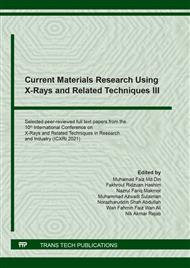[1]
M. R. Havstad, Chapter 5 - Biodegradable plastics,, in Plastic Waste and Recycling, T. M. Letcher, Ed. Academic Press (2020). 97–129.
DOI: 10.1016/b978-0-12-817880-5.00005-0
Google Scholar
[2]
J. H. Kim, B. S. Shim, H. S. Kim, Y. J. Lee, S. K. Min, D. Jang, Z. Abas, and J. Kim, Review Of Nanocellulose For Sustainable Future Materials. International Journal Precis. Engineering and Manufacturing- Green Technology. 2 (2015) 197–213.
DOI: 10.1007/s40684-015-0024-9
Google Scholar
[3]
A. A. Septevani, A. Rifathin, A. A. Sari, Y. Sampora, G. N. Ariani, Sudiyarmanto and D. Sondari, Oil palm empty fruit bunch-based nanocellulose as a super-adsorbent for water remediation. Carbohydrate Polymers. 229 (2019) 115433.
DOI: 10.1016/j.carbpol.2019.115433
Google Scholar
[4]
M. Asim, K. Abdan, M. Jawaid, M. Nasir, Z. Dashtizadeh, M. R. Ishak and M. E. Hoque, A review on pineapple leaves fibre and its composites. International Journal of Polymer Science. Vol. (2015).
DOI: 10.1155/2015/950567
Google Scholar
[5]
W. Jiang, S. Liu, C. Zhou, S. Gao, Y. Song, W. Li, W. Zhu, Y. Lv and G. Ting, Preparation of nanocellulose directly from kenaf bast: The change in particle size. BioResources. 13 (2019) 5598–5607.
DOI: 10.15376/biores.13.3.5598-5607
Google Scholar
[6]
P. Phanthong, P. Reubroycharoen, X. Hao, and G. Xu, Nanocellulose : Extraction and application. Carbon Resource Conversion. 1 (2018) 32–43.
DOI: 10.1016/j.crcon.2018.05.004
Google Scholar
[7]
L. N. V. K. D. Lavanya, P.K. Kulkarni, M. Dixit, P. K. Raavi, Sources of cellulose and their applications- A review International Journal Of Drug Formulation And Research Sources Of Cellulose And Their Applications. 2 (2011) 19–38.
Google Scholar
[8]
N. A. A. N. Yusuf, M. K. A. A. Razab, M. B. A. Bakar, J.Y. Khor, W. T. Chee, R. S. M. Ghani and M. N. Nordin, Determination of structural, physical, and thermal properties of biocomposite thin film from waste banana peel. Jurnal Teknologi. 81 (2018).
DOI: 10.11113/jt.v81.12599
Google Scholar
[9]
N. S. Rosli, S. Harum, J. M. Jahim, and R. Othaman, Chemical and Physical Characterization of Oil Palm Empty Fruit Bunch. Malaysian Journal of Analytical Sciences. 21 (2017)188–196.
DOI: 10.17576/mjas-2017-2101-22
Google Scholar
[10]
N. Elias, S. Chandren, N. Attan, N. A. Mahat, F. I. A. Razak, J. Jamalis and R. A. Wahab, Structure And Properties Of Oil Palm-Based Nanocellulose Reinforced Chitosan Nanocomposite For Efficient Synthesis Of Butyl Butyrate. Carbohydrates Polymer. 176 (2017) 281–292.
DOI: 10.1016/j.carbpol.2017.08.097
Google Scholar
[11]
C. Pang, R. A. Shanks, and F. Daver, Characterization Of Kenaf Fiber Composites Prepared With Tributyl Citrate Plasticized Cellulose Acetate. Composite Part A Applied Science and Manufacturing. 70 (2014) 52–58.
DOI: 10.1016/j.compositesa.2014.12.003
Google Scholar
[12]
Z. N. Azwa, B. F. Yousif, A. C. Manalo, and W. Karunasena, A Review On The Degradability Of Polymeric Composites Based On Natural Fibres. Material and Design, 47 (2013) 424–442.
DOI: 10.1016/j.matdes.2012.11.025
Google Scholar
[13]
F. A. Mocktar, M. K. A. A. Razab, and A. M. Noor, Incorporating Kenaf And Oil Palm Nanocellulose In Building Materials For Indoor Radon Gas Emanation Reduction. Radiation Protection and Dosimetry. 189 (2020) 69–75.
DOI: 10.1093/rpd/ncaa014
Google Scholar
[14]
N. A. Mocktar, M. K. A. Abdul Razab, A. Mohamed Noor, and N. H. Abdullah, Preparation And Characterization Of Kenaf And Oil Palm Nanocellulose By Acid Hydrolysis Method. Material Science Forum. 1010 (2020) 495–500.
DOI: 10.4028/www.scientific.net/msf.1010.495
Google Scholar
[15]
S. P. Mishra, A. S. Manent, B. Chabot, and C. Daneault, Production Of Nanocellulose From Native Cellulose - Various Options Utilizing Ultrasound. BioResources. 7 (2012) 422–435.
DOI: 10.15376/biores.6.1.121-143
Google Scholar
[16]
M. K. A. Abdul Razab, R. S. Mohd Ghani, F. A. Mohd Zin, N. A. A. Nik Yusoff, and A. Mohamed Noor, Isolation and Characterization of Cellulose Nanofibrils from Banana Pseudostem, Oil Palm Trunk, and Kenaf Bast Fibers Using Chemicals and High-intensity Ultrasonication. Journal of Natural Fibers. (2021) 1–14.
DOI: 10.1080/15440478.2021.1881021
Google Scholar
[16]
S. N. Surip, W. N. R. Wan Jaafar, N. N. Azmi, and U. M. K. Anwar, Microscopy Observation On Nanocellulose From Kenaf Fibre. Advanced Material Resources. 488 (2012) 72–75.
DOI: 10.4028/www.scientific.net/amr.488-489.72
Google Scholar
[18]
L. Jasmania, W. Thielemans, Preparation Of Nanocellulose And Its Potential Application. International Journal Of Nanomater, Nanotechnology and Nanomedicine. 4 (2018) 14–21.
DOI: 10.17352/2455-3492.000026
Google Scholar
[19]
M. K. A. A. Razab, R. S. Mohd Ghani, A. M. Noor, N. A. Mocktar, F. A. Mohd Zin, N. H. Abdullah, N. A. A. Nik Yusuf and M. Mohamed, Kenaf Cellulose Nanofibrils As Mechanical Enhancers Of Composite Brick," AIP Conference Proceedings. 2068 (2019) 1–6.
DOI: 10.1063/1.5089370
Google Scholar
[20]
M. T. Nooman, Effect of Zeolite Inclusion on Some Properties of Concrete and Corrosion Rate of Reinforcing Steel Bars Imbedded in Concrete. IOSR Journal: Mechanical and Civil Engineering e-ISSN. 13 (2016) 51–59.
Google Scholar
[21]
M. R. K. Sofla, R. J. Brown, T. Tsuzuki, and T. J. Rainey, A Comparison Of Cellulose Nanocrystals And Cellulose Nanofibres Extracted From Bagasse Using Acid And Ball Milling Methods. Advanced Natural Science: Nanoscience, Nanotechnology. 7 (2016).
DOI: 10.1088/2043-6262/7/3/035004
Google Scholar


